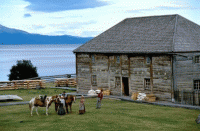Blog Categories
- Blog home
- Cariboo Chilcotin Coast (9)
- Mighty Fraser Country (19)
- Northern BC (10)
- The Kootenays (17)
- Thompson-Okanagan (19)
- Tourism Associations (3)
- Uncategorized (0)
- Vancouver (197)
- Vancouver Coast Mountains (26)
- Vancouver Island (110)
- Victoria (57)
- Whistler (17)
Related Travel Information
Fort St. James National Historic Site
- Author: Shoelady
- Accommodation: Northern BC
My daughter and I first visited the Fort St. James National Historic Site in July of 2008. I have a sister who’s been living in Fort St. James for the past five years, and we’ve gone to visit her almost every summer, since my 8-year-old daughter was born.
The town of Fort St. James is on the shores of Stuart Lake, 164 kilometres northwest of Prince George. The town is small (more of a village, really) and the scenery in this part of BC is beautiful. The lake is quite large and is great for swimming, boating and fishing in the summer.
Fort St. James was originally established by Simon Fraser for the North West Company in 1806 and was the second permanent fur trade post constructed west of the Rocky Mountains. It became a Hudson Bay Company post when the two companies merged. The Fort was the business hub for the area called New Caledonia. The historic site displays the largest group of original wooden buildings representing the fur trade in Canada. The site revolves around the relationships and interactions between the fur traders and Native Peoples of the region, namely the Carrier First Nations.
Although today it is restored to a single year in time, 1896, the story played out spans about one hundred and forty six years, starting with the arrival of the fur traders and ending in 1952, when the Hudson’s Bay Company closed shop on the original site.
There are many opportunities to meet and talk to site interpretive staff in period costume, which we did. Each building had a different purpose and staff to explain its significance.
What they call ‘Living History’ is featured from mid-May to September 30. The staff dressed in period costume to carry out daily chores and activities that portrayed the lifestyle of this post in 1896. We were able to walk unescorted through the fort and interact with the animators.
Activities take place daily (weather permitting). These include: gardening in the huge vegetable garden, tending the cattle and chickens, packing and riding horses, hewing and peeling logs, fence painting and cooking. In season, there are traditional First Nations Activities at the Fort such as hide tanning and salmon preparation.
Just outside the visitor centre is the Old Fort Caf




